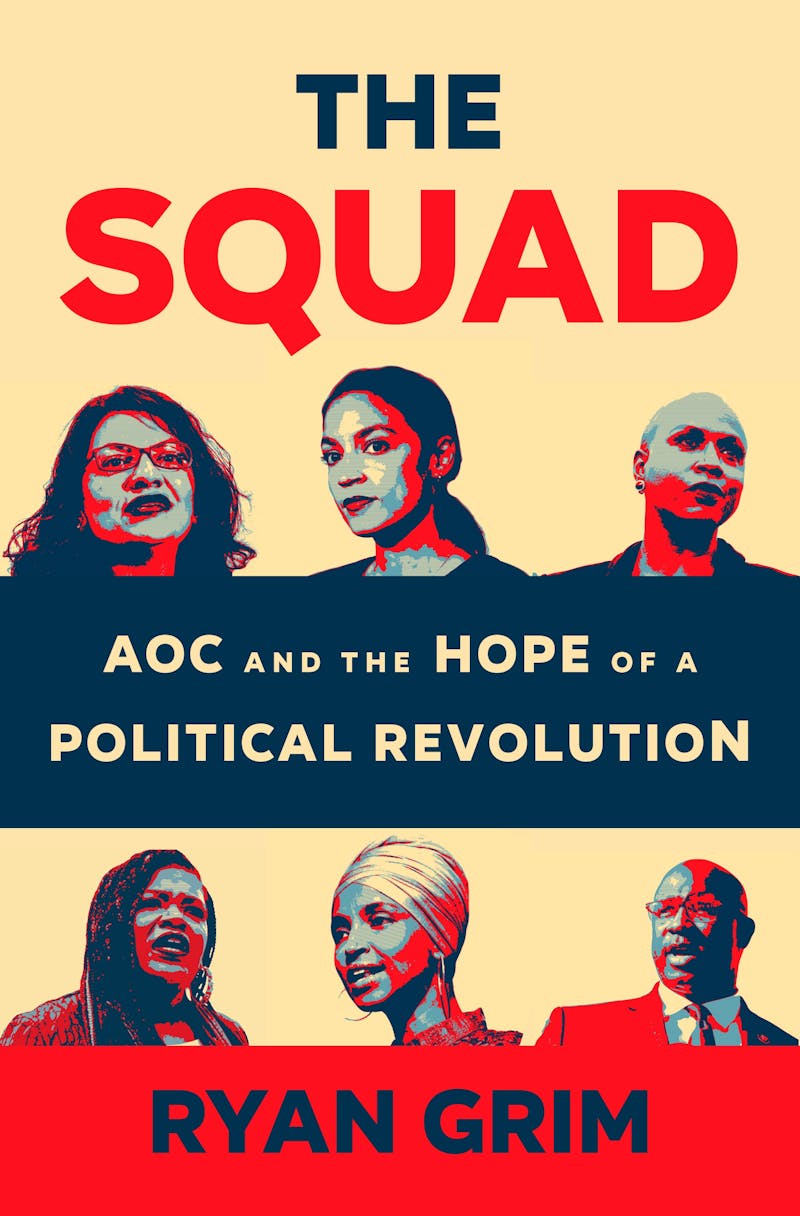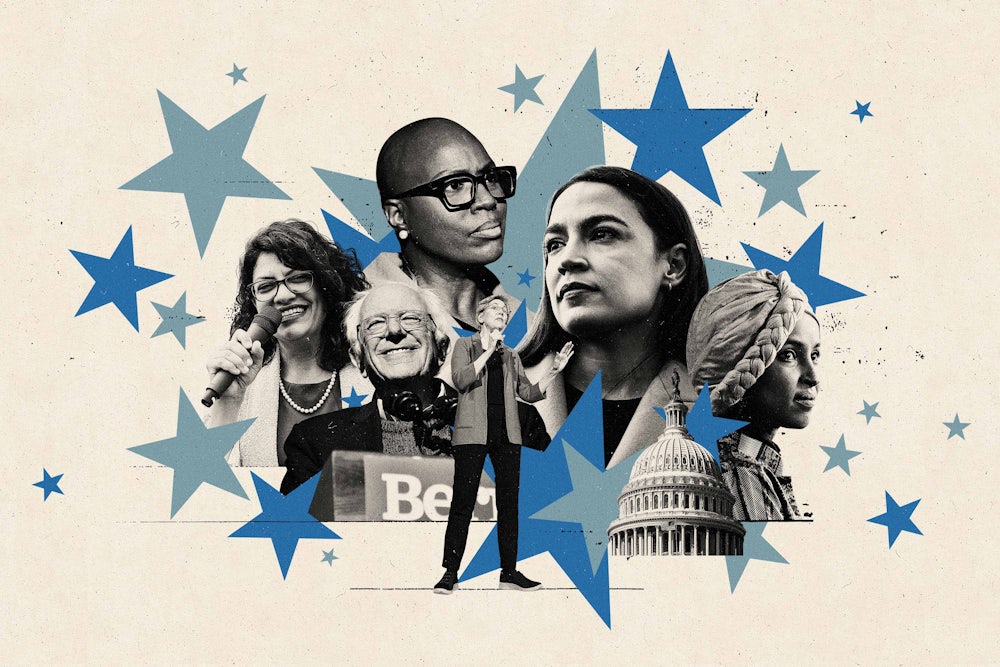On January 3, 2019, lawmakers gathered on Capitol Hill to swear in the 116th Congress. Democrats were in great spirits, since they were now in control of the lower chamber. Following a dispiriting two years when President Donald Trump and the GOP ran roughshod through President Barack Obama’s legacy and shattered governing norms on a daily basis, Speaker of the House Nancy Pelosi was determined to put the brakes on renegade Republicans whom Democrats perceived as a serious threat to the stability of the country.
Among the most prominent new Democrats on the floor that day were four women who had campaigned on a bold domestic agenda that grew out of the ideas circulating among young social Democrats who were sick and tired of the neoliberalism that had reshaped the party of Franklin Roosevelt and Lyndon Johnson since the 1990s. Alexandria Ocasio-Cortez (New York), Rashida Tlaib (Michigan), Ayanna Pressley (Massachusetts), and Ilhan Omar (Minnesota) stood on the floor with ambitions of transforming the Democrats into something more than an alternative to the GOP. Liberalizing immigration laws, funding for social services, police reform, universal health care, and a robust social safety net were all components of what they hoped to achieve. The new progressives were young, charismatic, nonwhite, and they came into office refusing to be told by their elders what to do—they were “unbought and unbossed,” to use a phrase from the late New York Representative Shirley Chisholm, who famously took on the conservative Southern barons of the Democratic Party in the early 1970s. AOC wore an all-white suit to honor all “the women who paved the path before me, and for all the women yet to come. From suffragettes to Shirley Chisholm,” the congresswoman said, “I wouldn’t be here if it wasn’t for the mothers of the movement.”

“The Squad,” as they would be called, were not standing alone. As soon as they started their term, they joined a broader progressive coalition working to push the party leftward. In the House, Representative Pramila Jayapal (Washington state) headed these efforts through the Congressional Progressive Caucus, and in the Senate, Bernie Sanders of Vermont, Sherrod Brown of Ohio, and Elizabeth Warren of Massachusetts had been rejecting the conventional wisdom among the party leaders about what was pragmatically possible and what should not even be considered. All of these elected officials rejected the logic of President Bill Clinton, recently chronicled in Nelson Lichtenstein and Judith Stein’s A Fabulous Failure, that the only way for Democrats to survive in a conservative age was market-based centrism. Ever since the financial collapse of 2008, the protests of Occupy Wall Street had propelled economic concerns to the forefront of their agenda. In 2016, Senator Sanders’s serious challenge to Hillary Clinton in the primaries had convinced AOC and others that running from the left could generate substantial electoral support.

Once they were in office, the question was, “What do we do now?” to quote Robert Redford’s character in The Candidate, an inexperienced Senate hopeful who somehow manages to win. More pertinent was the question of whether a small band of left-of-center members of Congress could have an impact.
Two new books about this generational cohort—Ryan Grim’s The Squad and Joshua Green’s The Rebels—try to answer this question. Grim undertakes this challenge with a detailed, behind-the-scenes narrative of the Squad’s first few years in office. Trying to take a broader perspective, Green, whose last book chronicled Steve Bannon and his brand of conservative populism, profiles Warren, Sanders, and AOC to explore how progressive populism has already struck a blow against Democratic neoliberalism and opened the door to a new era in party politics.
Grim is at his best when examining the efforts of Speaker Pelosi; New York’s Hakeem Jeffries, chair of the House Democratic Caucus; and New Jersey Representative Josh Gottheimer, a co-founder of the Problem Solvers Caucus, to stop the Squad in their tracks. They pounced when Minnesota Representative Ilhan Omar made poor choices in her rhetoric and tweets about foreign policy that opened up room for them to attack her as antisemitic. (Grim suggests she was not antisemitic but didn’t understand the implications of her words, such as when she tweeted that “it’s all about the Benjamins baby” to explain U.S. support for Israel.) It is fascinating to see how the issue of Israel, not originally a central concern for AOC, turned into a major challenge and wedge between the left and the rest of the party, especially when Gottheimer as well as the GOP tried to capitalize on policy positions and public comments to depict the entire cohort as antisemitic. These fault lines have become more severe since the book was written, with Hamas’s brutal attack on Israelis on October 7 and the fallout that then took place in the United States as a number of progressive legislators refused to unambiguously condemn the atrocities, while several of their colleagues showed vigorous support for Israel’s war in Gaza (and 22 Democrats joined Republicans to censure Tlaib for her comments on the conflict). The resulting tensions will require a great deal of political work to overcome.
The new voices in Congress were not easily intimidated. That was clear as early as the orientation for the incoming class, held at Harvard’s Institute of Politics, when AOC became frustrated at hearing from members of the Trump administration, bipartisan centrists, and conservative intellectuals, all sponsored by business. “# of Corporate CEO’s we’ve listened to here: 4. # of Labor Leaders: 0,” she tweeted to her followers.
Besides examining the opposition that the Squad faced from fellow Democrats, Grim also highlights the internal fighting, missteps, mistakes, and blind spots within the progressive coalition that were extremely damaging. Representative Jayapal, for instance, who had built a reputation on climate issues, reportedly wasn’t happy when AOC stormed into Washington, literally, and took on the issue as her own. Grim does an excellent job of offering behind-the-scenes stories of the high-stakes battles among top staffers who were influential figures in these legislative offices.
The party infighting sometimes could feel as intense as the battles waged against President Trump. Grim recounts how AOC’s chief of staff, Saikat Chakrabarti, and Pelosi ended up going mano a mano via the press. Over omelets at a San Francisco restaurant, the speaker warned columnist Maureen Dowd that the Squad had been unrealistic and unproductive in opposing a bipartisan government funding and border deal, quipping, “they didn’t have any following. They’re four people and that’s how many votes they got.” The same week, Chakrabarti approved a quote (which AOC did not approve) in The Washington Post alleging that the leadership was “driven by fear” and “unable to lead.” The situation became so heated that, during a caucus meeting, Pelosi sternly lectured staffers who were saying and tweeting things about the leadership without directly confronting her—a statement targeting Chakrabarti. That the meeting took place right around the time a profile of Chakrabarti appeared in The Washington Post didn’t help. Jeffries jumped into the fray by going “nuclear on him,” Grim argues, with a social media post of his own, accusing him of targeting Representative Sharice Davids, who is a Native American. The infighting just multiplied.
After the murder of George Floyd in 2020, Grim shows, many allied organizations became more focused on identity politics and internal feuding than on their original mission. The Sunrise Movement, comprising young environmental activists committed to fighting climate change, was roiled by internal division over race, as the Black Sunrise Caucus denounced the leadership for allowing the movement to “exploit our voices, body, and labor.” Meanwhile, major organizations such as Planned Parenthood and the Sierra Club felt the need to put out statements denouncing their founders for their association with eugenics, to the chagrin of activists who felt that they were redirecting energy away from their common goals. One former executive director of a progressive advocacy organization told Grim that, by the early 2020s, about 90–95 percent of his time had been consumed with “internal strife,” compared to 25–30 percent, “tops,” just a few years earlier.
Grim is critical of younger, Twitter-oriented activists who, he argues, were part of a “general reorientation” away from the kind of structural issues that mattered to Senator Sanders and older leftists. “A sense of powerlessness on the left had nudged the focus away from structural or wide-reaching change,” he writes, “which felt hopelessly beyond reach, and replaced it with an internal target that was more achievable.” As the left purged their own ranks and descended into Zoom room wars, Republicans kept marching along, deregulating, cutting taxes, and building border walls.
Green is more effective than Grim at keeping readers’ attention on the big picture. His narrative, focused on three well-written profiles, is easier for nonspecialists to digest. According to Green, Democrats had abandoned core party traditions beginning in the late 1970s, starting surprisingly with President Jimmy Carter’s support of the Revenue Act of 1978, legislation that redirected “investment from factories and equipment to financial instruments” and created 401(k) accounts that undermined the post–World War II commitment of employers to provide retirement security. That was just the opening bell. Green writes about how a number of Democratic party builders, such as California Representative and Majority Whip Tony Coelho, aggressively courted business and financial leaders to compete with Republican fundraising efforts.
What started as a pragmatic effort to keep up with the GOP turned into an ideological affinity toward market-based policy solutions. (This was the focus of historian Lily Geismer’s recent book, Left Behind.) The result, according to Green, was the rise of economic policymakers such as Robert Rubin, Tim Geithner, and Larry Summers, who ascended to the highest levels of power under Presidents Clinton and Obama. As Democrats expanded their agenda to focus on social and cultural issues of concern to suburban middle-class voters, working-class Americans were left behind.
This, Green shows, is where the current legislative giants of the left step in. Each one of them played a part in expanding support for progressive ideas that attempted to address the problem of economic inequality. They envisioned a Democratic Party recommitted to Main Street rather than Wall Street. Senator Warren was an agenda-setter, using her experience as a professor of economics to shape the debate around new forms of government regulation to protect middle-class investors. Of all the characters in the book, Warren comes out shining brightest. She was, as Green notes, “expert at tapping into the broad discontent in American society—far better than Obama—and giving expression to middle-class grievances.” Senator Sanders ran two major campaigns, attracting serious support, around straightforward proposals to ease working Americans’ financial burdens of education, health care, and poor wages. AOC, a former bartender who started her political career by occupying the office of Speaker Pelosi, turned into a savvy and effective politician who understood what it took to turn ideas into real legislation. “It became not uncommon,” Green found, “to hear positive comments from colleagues surprised and enchanted that the diligently prepared woman with whom they established productive working relations wasn’t the socialist firebrand her public image suggested.”
Their ideas were popular with the public. All three of them understood how to operate in a modern media landscape defined by cable television and social media to convey messages even when powerful colleagues opposed them. When the older generation of Democratic leaders retire, Green believes that figures like AOC will have a serious chance to take over.
In keeping their eye trained on the internal struggles of the Democrats, both authors tend to downplay the giant elephant in the room: a radicalized Republican Party and the massive conservative media ecosystem that is extremely effective at shaping the national conversation. Regardless of how united the Democrats were or how appealing their ideas might be at the electoral level (whether left or center), success will remain extraordinarily difficult when confronting an opposition party that has moved in asymmetric fashion; is willing to deploy ruthless partisan tactics, such as threatening to not raise the debt ceiling and shutting down the federal government; and holds the line on far-right ideas. Indeed, we have now entered a realm where it is not even clear that Republicans will accept the result of a legitimate election.
While Democrats wrestled over whether criticism of Israel was the same as anti-semitism, right-wing organizations—and elected officials all the way up the president—trafficked in language that clearly targeted American Jews, and white nationalist organizations found their way into the political orbit of the GOP. Republicans also benefited from something else that does not receive enough attention from these authors: the anti-majoritarian structural elements of our institutions—such as the composition of the Senate and the Electoral College—that work against what members of the left are trying to achieve, even when their ideas command strong support within the electorate.
Nor does either book provide much of a historical background on the left’s previous struggles in Congress. This is a missed opportunity, and readers won’t have much sense that these kinds of left-of-center coalitions have been essential to the history of twentieth- and twenty-first-century liberalism. (Grim mentions in passing the late California Democrat Phil Burton, but that’s about it.) Understanding the history is not simply an intellectual corrective but roots the subject of these books in a much longer tradition that has proved to be extraordinarily effective. Left legislators have been fighting for what historians Lizabeth Cohen and Michael Kazin have called “moral capitalism.” Without rejecting the marketplace, they have demanded that the federal government step in to ensure that economic justice and security protect against the swings and damage rendered by a capitalist system.
Left legislators—who have been called many things over the years: progressives, left-of-center, bomb-throwers, renegades, and more—belie the myth that the left side of the spectrum is only filled with starry-eyed idealists who have no sense of real-world politics. With an emphasis on grassroots activists and charismatic movement leaders, historians of the left tend to stress the ways that social justice has been pursued by figures who are outside of high politics. They fight the good fight, so the narrative goes, by mobilizing regular citizens, rallying support through dramatic demonstrations, sticking to principle, and demanding that those inside Washington don’t sell out their values.
In contrast to this caricature, since the early twentieth century, left legislators have been organizing, mobilizing, coalition-building, and legislating from within Capitol Hill. We have seen this in the past, and we are seeing this again today. Without New York Senator Robert Wagner, for example, much of the New Deal might never have come into being. The senator and his allies in the upper chamber had been fighting to expand the role of government before there was a Great Depression or Franklin Roosevelt was president. Even once FDR was in office, the senator was the driving force behind landmark legislation such as the National Labor Relations Act, which legitimated unions and created a government body to oversee union rights—and is correctly known as the “Wagner Act.” Many of the policies we now associate with Roosevelt were born out of Wagner’s efforts. As the political scientist David R. Mayhew wrote in America’s Congress, “it is a fair question whether the 1930s, at least as an epic legislative era, should not be labeled ‘the age of Wagner’ as much as it is the ‘age of Roosevelt.’”
In the 1940s and 1950s, Minnesota Senator Hubert Humphrey, who started his career at the 1948 Democratic Convention telling Southerners to leave the party if they didn’t want to embrace the cause of civil rights, served a similar role. He lashed out against senior Southern Democrats who resisted racial justice and violated the norms of the chamber. Humphrey used radio and television to get out his message when the party hierarchy (literally) ignored him. During the 1950s, Senate Majority Leader Lyndon Johnson persuaded him to curb his behavior by coming closer to the leadership, but in exchange Humphrey was able to serve as a bridge to liberals like Illinois Senator Paul Douglas, Pennsylvania’s Joseph Clark, and New York Senator Herbert Lehman. Humphrey ensured they had the ear of Senator Johnson, and that their ideas remained part of the mix. The legislative left on Capitol Hill—though kept at arm’s length by LBJ—put a series of issues on the table, such as providing health care to the elderly and ending legal segregation, that would become the law of the land in the 1960s. They served the agenda-setting function that is so vital over the long term, even when obtaining actual legislation can take decades.
A major turning point took place in 1959, when Northern liberals in the House formed the Democratic Study Group, or DSG. This caucus, an outgrowth of an informal cluster of Democrats led by Eugene McCarthy (McCarthy’s Mavericks), was determined to counteract the procedural prowess of Southern Democratic conservatives who used rules and norms to stifle progress on issues such as civil rights and health care. DSG believed that left-of-center Democrats—the progressives of the time—needed to focus more on organization if they wanted to achieve their goals. DSG disseminated key information to allied legislators, mobilized and counted votes on pertinent bills, and pressured the speaker to take seriously the ambitions of the left. Like Humphrey in the late 1940s, DSG members turned to the media to get out the kinds of messages that the Democratic leadership tried to contain. During the high point for liberalism in the mid-1960s, DSG emerged as an important ally to President Johnson in the passage of the Great Society. A decade later, in the aftermath of Watergate, the group was at the forefront of efforts to curb the power of Southern committee chairmen and strengthen the hand of centralized party leadership.
During the 1990s, the Congressional Progressive Caucus, formed in 1991, attempted to serve a similar function. CPC, whose founders included Representatives Ron Dellums and Bernie Sanders, was not as effective as DSG—never as organized and not quite as shrewd in terms of parliamentary strategy. Yet it created legislative space for those who were more concerned about issues such as universal health care and economic inequality, ensuring a presence for ideas that were losing a place in Washington. Under Representative Jayapal, CPC became much stronger in the second half of Trump’s presidency, providing a solid voting bloc on a number of key issues, including the first impeachment proceedings, when the leadership was hesitating. In 2020, Jayapal pushed through important rule changes that strengthened the ability of the caucus to vote as a single bloc on legislation and improved participation rates (in certain respects, mimicking the Freedom Caucus).
Neither book includes much of this congressional history in its narratives. Had the authors done so, they would have seen how many of the challenges, intraparty tensions, and accomplishments have happened before—and readers could think more about how the current cohort fits in a long-term trajectory. In the early 1960s, for instance, the Democratic Study Group found an opening to influence mainstream Democratic politics by demonstrating its ability to deliver solid blocs of votes that could strengthen the broader standing of the entire party. DSG became a pivotal player after the 1964 election in helping to mobilize legislative support, and applying pressure on recalcitrant committee chairs, to enact the Great Society. Today’s left has yet to emulate that success as a voting bloc, even with the gains they have made; to do so they will need to institute mechanisms that ensure maximum unity and rely on members like AOC, without attacking them for “selling out” when they build bridges to the leadership, just as Senator Humphrey did.
There is in this history a bigger lesson about the power of legislative organization—even for figures who come from marginalized parts of a party coalition—to impact ideas and policies. For those on the left looking ahead, Grim’s and Green’s accounts are also a valuable reminder that, in addition to having rallies on the streets and getting the ear of the president, members of the left need to keep an eye on Capitol Hill, supporting and growing the Squad and their allies so that they have the organizational muscle needed to keep and push their issues until windows of opportunity for legislating emerge.




